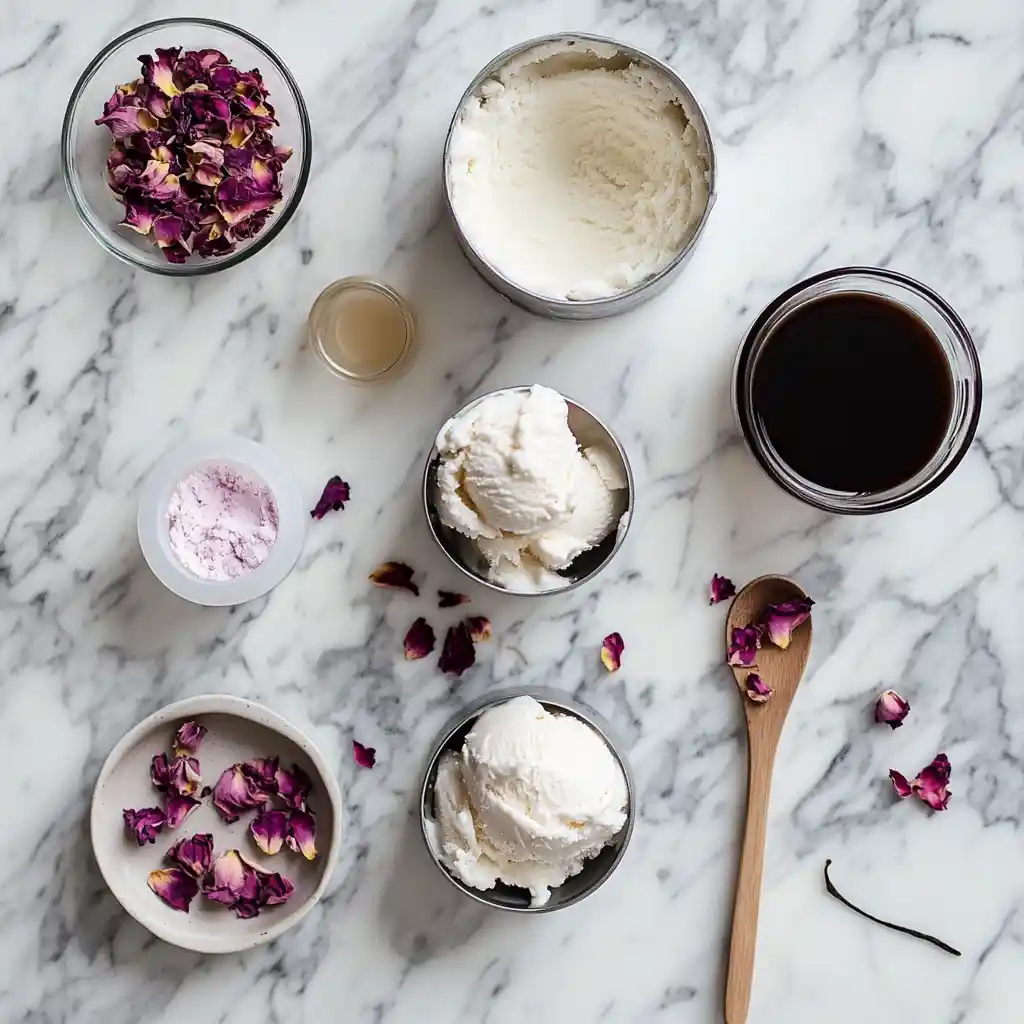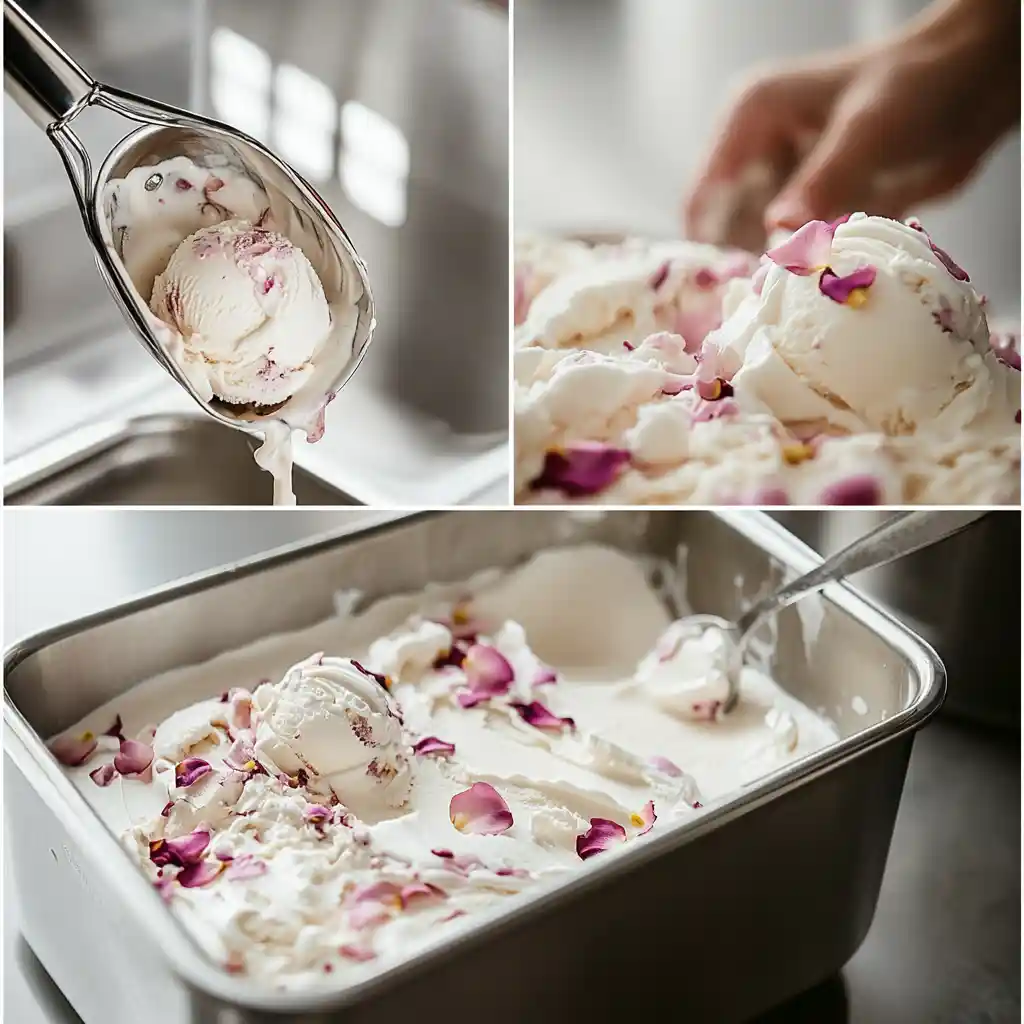
Table of Contents
There’s something undeniably magical about floral desserts. And when I first tasted ice cream with rose petals, I was instantly transported to a sunny spring afternoon in my mother’s garden. This article is all about how to bring that same plant-based magic into your own kitchen. From the delicate flavor of dried rose petals to the creamy richness of coconut milk, we’re blending tradition and freshness into one unforgettable dessert. Whether you’re curious about what rose petal ice cream tastes like or planning your own botanical brunch, we’ll cover everything—from history to serving ideas—starting with the story behind the recipe.
The Floral Tale Behind Ice Cream with Rose Petals
A Flavor Rooted in Memory and Culture
My first encounter with rose petal ice cream wasn’t in a restaurant—it was in a potluck garden party. Someone had churned a small batch, pale pink and speckled with real petals. I remember the look on everyone’s face after their first bite: quiet, surprised joy. It was unlike anything else—delicately sweet, aromatic, and nostalgic. That moment became the seed of my obsession with floral-infused desserts. In cultures from India to the Middle East, rose water has long flavored sweets like kulfi and Turkish delight. I wanted to bring that elegance into a dairy-free, plant-powered format.
Why Rose Petal Ice Cream Works—Even for Skeptics
You might wonder, what does rose petal ice cream taste like? Think of a mild, floral vanilla with soft notes of berries and honey. When paired with plant-based ingredients like coconut cream or cashew milk, the flavor blooms—subtle but unforgettable. The ice cream isn’t perfume-like, just naturally fragrant. Adding crushed or whole rose petals offers not just taste but texture and visual beauty. If you’re crafting a future menu around botanical recipes like Rose Petal Lemonade, this is the dessert that completes the table. And unlike artificial floral flavors, using dried edible rose petals or rose water creates a clean, refreshing finish—ideal after a warm day or spicy meal.
How to Make Ice Cream with Rose Petals at Home
Plant-Based Ingredients That Make It Creamy and Elegant
Creating ice cream with rose petals isn’t just about the floral notes—it’s about balancing creaminess and clarity of flavor. For the base, full-fat coconut milk is my go-to. It mimics dairy richness while letting the rose shine. If you prefer something subtler, cashew cream or almond milk can work, though you may need to adjust for thickness. Rose water is essential—just a teaspoon can elevate the whole batch. Edible dried rose petals, available online or in Middle Eastern stores, add texture and visual appeal. A touch of maple syrup or agave syrup provides clean sweetness without overshadowing the floral.

Here’s a sample base formula for about 1 quart:
| Ingredient | Amount |
|---|---|
| Full-fat coconut milk | 2 cans (13.5 oz each) |
| Maple syrup | 1/3 cup |
| Rose water | 1 tsp (up to 1½ tsp) |
| Dried edible rose petals | 2 tbsp |
| Vanilla bean (optional) | 1 tsp |
Simple Steps—With or Without an Ice Cream Maker
Once your base mixture is ready, follow these steps to freeze your ice cream with rose petals:
With an ice cream maker:
- Chill the mixture in the fridge for at least 2 hours or until cold.
- Pour the mixture into your ice cream maker that’s already been chilled ahead of time.
- Churn according to your machine’s instructions—usually 20 to 25 minutes.
- Once it reaches a soft-serve consistency, transfer it to a lidded container.
- Freeze for 3–4 hours until scoopable.
Without an ice cream maker:
- Pour the cold mixture into a shallow dish that’s safe for the freezer.
- Place it in the freezer and let it sit for 30–40 minutes.
- Remove and stir vigorously with a fork or hand mixer to break up ice crystals.
- Stir the mixture every 30 minutes for roughly 3 hours, repeating the process until it reaches the right texture.
- Freeze until fully set.

For a beautiful finishing touch, sprinkle crushed rose petal flakes on top just before serving. They add visual elegance and subtle texture—especially when paired with future floral recipes like Rose Petal Lemonade.
Flavor Pairings & Variations That Complement Rose
Flavors That Bring Out the Best in Rose
Rose has a delicate flavor profile, so pairing it wisely is key. It works best with ingredients that either contrast gently or echo its floral quality. One classic match is pistachio. The nutty, slightly savory notes balance rose’s sweetness beautifully. Lemon zest or even candied lemon peel adds brightness and a touch of acidity—perfect for warm weather. This combo is ideal if you’re planning a garden-themed dessert board featuring your upcoming Rose Petal Lemonade recipe.
You can also lean into the creamy side. Coconut and rose are a dreamy duo, especially if your ice cream base uses coconut milk. Other excellent companions include vanilla bean, saffron, almond extract, and even a whisper of cardamom for depth. If you enjoy floral blends, lavender or hibiscus can be stirred in carefully for a layered botanical experience.
Creative Ways to Customize the Base
Once you’ve nailed the original recipe, don’t be afraid to experiment. Here are some simple ways to make it your own:
- Add texture: Swirl in crushed pistachios, rose petal jam, or chopped Turkish delight for bursts of flavor.
- Infuse depth: Simmer dried rose petals in your coconut milk before blending for a more aromatic ice cream.
- Go fruity: Blend in a touch of raspberry or strawberry puree to give it a natural pink hue and a fruity contrast.
- Refined sweetness: Swap maple syrup with date syrup or agave if you prefer a different glycemic profile.
Even more exciting? Each of these tweaks layers beautifully with desserts, teas, and future recipes like the Rose Petal cookies you’re probably already dreaming up.
How to Serve, Style, and Store Ice Cream with Rose Petals
Serve It Beautifully—Because Presentation Matters
When you serve ice cream with rose petals, lean into its natural elegance. Use a chilled bowl or coupe glass for that extra-luxe feel. A few dried rose petals scattered on top add immediate visual appeal, and a drizzle of rose syrup or a light dusting of crushed pistachios can elevate it from simple scoop to showstopper.
Pairing ideas? Serve alongside almond shortbread, pistachio brittle, or a glass of lightly sweetened Rose Petal Lemonade for a floral-themed dessert course that feels both refreshing and indulgent. Hosting a brunch? Scoop mini servings into espresso cups and top with edible gold leaf or a single fresh mint leaf for contrast.
You can also turn it into an ice cream sandwich using soft vegan sugar cookies or layer it in a parfait with coconut whipped cream and raspberry compote. Let your creativity bloom—this flavor invites it.
Store It Right to Keep the Texture Perfect
Homemade ice cream doesn’t contain commercial stabilizers, so proper storage helps preserve its texture and flavor. After churning or mixing:
- Transfer your finished ice cream to a shallow, airtight container.
- Press a piece of parchment paper or wax paper directly onto the surface before sealing. This prevents ice crystals.
- Store it in the coldest part of your freezer, usually the back.
It will keep best for 1–2 weeks. When ready to serve, let it sit at room temperature for about 5–7 minutes before scooping. The floral notes become more aromatic when slightly softened—just enough to remind your taste buds of a blooming rose petal in springtime.
Frequently Asked Questions About Ice Cream with Rose Petals
What does rose petal ice cream taste like?
Rose petal ice cream has a gentle, floral flavor that’s soft and aromatic. It’s often compared to a blend of vanilla, wild berries, and a hint of honey. When made with plant-based milks like coconut or cashew, it’s creamy with a refreshing, slightly exotic finish—never overpowering or perfumed when balanced properly.
What is the name of the rose petal ice cream?
In many Middle Eastern and South Asian cultures, rose petal ice cream is known as “Gulkand ice cream” or simply “rose ice cream.” Gulkand refers to a sweet preserve made from rose petals. In Western-style vegan cooking, it’s usually labeled as “rose petal ice cream” or “vegan rose ice cream.”
What does freezing rose petals do?
Freezing rose petals helps preserve their color and texture. If you’re using fresh petals in desserts like ice cream or Rose Petal cookies, freezing them can keep them vibrant. However, most recipes use dried edible rose petals for their concentrated flavor and longer shelf life.
What flavors go with rose petals?
Rose petals pair wonderfully with a variety of flavors—especially in plant-based recipes. Great companions include pistachio, lemon, cardamom, vanilla, almond, and coconut. If you’re planning a full floral-themed spread, try pairing with fruity accents like raspberry or future drinks like Rose Petal Lemonade for a beautifully cohesive menu.
Conclusion
Ice cream with rose petals isn’t just a dessert—it’s a moment. A quiet indulgence with deep cultural roots and endless ways to customize. Whether you’re using it to anchor a spring menu, serve at a gathering, or enjoy on your own porch with a spoon, this floral vegan treat hits that rare balance between comforting and surprising. Now that you’ve got the method, the flavor pairings, and the inspiration, all that’s left is to start. And soon, you’ll have a whole new floral dessert silo blooming around this sweet, rosy cornerstone.
Print
Ice Cream with Rose Petals
- Total Time: 240 minutes (includes chilling and freezing)
- Yield: 6 servings
- Diet: Vegan
Description
This vegan ice cream with rose petals is delicately floral, luxuriously creamy, and perfect for elegant dessert tables.
Ingredients
Full-fat coconut milk – 2 cans (13.5 oz each)
Maple syrup – 1/3 cup
Rose water – 1 to 1½ tsp
Dried edible rose petals – 2 tbsp
Vanilla bean (optional) – 1 tsp
Instructions
1. Chill coconut milk in fridge.
2. Mix all ingredients in a blender until smooth.
3. If using an ice cream maker, churn for 20–25 minutes.
4. Transfer to a lidded container and freeze for 3–4 hours until firm.
5. Without ice cream maker: pour into shallow dish, freeze, and stir every 30 minutes for 3 hours.
6. Let sit at room temperature 5 minutes before serving. Garnish with extra rose petals.
Notes
– Use only food-grade rose petals.
– Rose water intensity varies—start light and adjust.
– Pairs well with pistachios, almond cookies, or lemon accents.
- Prep Time: 10 minutes
- Cook Time: 0 minutes
- Category: Dessert
- Method: No Bake
- Cuisine: Middle Eastern Inspired
Nutrition
- Serving Size: 1 scoop
- Calories: 190
- Sugar: 9g
- Sodium: 12mg
- Fat: 16g
- Saturated Fat: 14g
- Unsaturated Fat: 2g
- Trans Fat: 0g
- Carbohydrates: 12g
- Fiber: 1g
- Protein: 1g
- Cholesterol: 0mg
Keywords: ice cream with rose petals, vegan rose dessert
